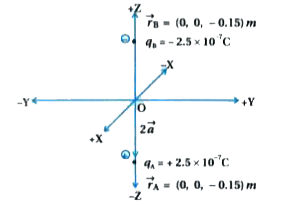A system has two charges qA=2.5×10−7 C and qB=−2.5×10−7 C located at points A:(0, 0, -15 cm) and B : (0, 0, + 15 cm), respectively. What are the total charge and electric dipole moment of the system ?
 Solution in Gujrati
Solution in Gujrati
Total charge of given system.
qA+qB=−2.5×10−7+2.5×10−7=0
Electric dipole moment of given dipole,
→p=(2→a)q={→r+−→r−}.q
=(→rA−→rB)q
=(0,0,−0.15)−(0,0,0.15)(2.5×10−7)
∴→p=(0,0,−0.3)(2.5×10−7)
∴p=7.5×10−8Cm (Along -Z axis)
Topper's Solved these Questions
- ELECTRIC CHARGES AND FIELDS BOOK - KUMAR PRAKASHANCHAPTER - ELECTRIC CHARGES AND FIELDS EXERCISE - SECTION B NUMERICALS (ADDITONAL EXERCISE)
10 Videos
- ELECTRIC CHARGES AND FIELDS BOOK - KUMAR PRAKASHANCHAPTER - ELECTRIC CHARGES AND FIELDS EXERCISE - SECTION B NUMERICALS (NUMERICAL FOR .DARPAN. BASED ON TEXTBOOK)
8 Videos
- ELECTRIC CHARGES AND FIELDS BOOK - KUMAR PRAKASHANCHAPTER - ELECTRIC CHARGES AND FIELDS EXERCISE - SECTION B NUMERICALS (NUMERICAL FROM TEXTUAL ILLUSTRATIONS)
24 Videos
- DUAL NATURE OF RADIATION AND MATTERBOOK - KUMAR PRAKASHANCHAPTER - DUAL NATURE OF RADIATION AND MATTEREXERCISE - Section-D (MCQs asked in GUJCET/Board Exam)
1 Videos
- ELECTROMAGNETIC INDUCTIONBOOK - KUMAR PRAKASHANCHAPTER - ELECTROMAGNETIC INDUCTIONEXERCISE - Section D MCQs (MCQs asked in Competitive Exams )
38 Videos
Similar Questions
An oil drop of 12 excess electrons is held stationary under a constant electric field of 2.55×104NC−1. (Millikan's oil drop experiment). The density of the oil is 1.26gcm−3. Estimate the radius of the drop, (g=9.81ms−2,e=1.60×10−19C).
View SolutionTwo spheres of copper, having mass 1 g each, are kept 1 m apart. The number of electrons in them are 1 % less than the number of protons. The electrical force between them is Atomic wt. of copper is 63.54 g/mol, atomic number is 29, Avogadro's number NA=6.023×1023mol−1 and k=9×109 SI
View SolutionHow can you charge a metal sphere positively without touching it ?
View SolutionMass of photon in motion is ………
View SolutionThree pure inductance each of 3 H are connected as shown in figure. The equivalent inductance of this connection between points A and B is ......

View SolutionA system has two charges q_(A)= +2.5xx10^(-7)C and q_(B)= +2.5xx10^(-7)C located at point A: (0,0,-15 cm)and B: (0,0,+15 cm) , respectively. What are the total charge and eletric dipole moment of the system?
View SolutionA system has two charges qA=+2.5×10−7CandqB=−2.5×10−7C located at point A: (0,0,-15 cm)and B: (0,0,+15 cm), respectively. What are the total charge and electric dipole moment of the system?

View SolutionA system has two charges qA=2.5×10−7C, and qB=−2.5×10−7C located at points A(0,0,−15cm) and B(0,0,+15cm). What are the total charge and electric dipole moment of the system?
View Solutionदो बिंदुवत आवेश qA=2.5×10−7C तथा qB=−2.5×10−7C क्रमश: दो बिंदुओं A(0,0,−15cm) तथा B(0,0,+15cm) पर स्थित हैं । निकाय पर कुल आवेश एवं विधुत-द्विध्रुव आघूर्ण (electric dipole moment) ज्ञात करें ।
View SolutionA system has two charges qA=2.5×10−7C and qB=−2.5×10−7C located at points A≡(0,0,−15cm) and B=(0,0,+15cm)respectively. What are the total charge and electric dipole moment of the system?
View Solutionकिसी निकाय में दो आवेश qA=2.5×10−7C तथा qB=−2.5×10−7C क्रमशः दो बिन्दुओ A:(0,0−15cm)तथा B:(0,0,+15cm )पर अवस्थ्ति है। निकाय का कुल आवेश तथा वैधुत द्विध्रुव आघूर्ण क्या है ?
View Solutionकिसी निकाय में दो आवेश qA=2.5×10−7 C तथा QB=−2.5×10−7 C क्रमशः दो बिन्दुओं A (0, 0, - 15 cm) तथा B(0,0, +15 cm) पर स्थित है निकाय का विद्युत द्विधुव आघूर्ण ज्ञात कीजिये।
View SolutionA system has two charges qA=2.5×10−7CandqB=−2.5×10−6C located at paint A: 0, 0, -15 cm) and B: (0, 0, +15 cm), respectively. What are the total charge and electric dipole moment of the system?
View SolutionA system has two charges qA=2.5×10−7 c and QB=−2.5×10−7 c located at points a (0,0,-15 cm) and B:(0,0+15cm) respectively what are the total charge and electric dipole moment of the system
View SolutionA system has two charges qA=2.5×10−7 c and QB=−2.5×10−7 c located at points a (0,0,-15 cm) and B:(0,0+15cm) respectively what are the total charge and electric dipole moment of the system
View Solution
